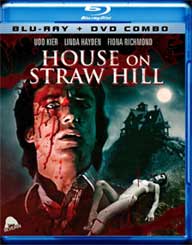 HOUSE
ON STRAW HILL (1976) Blu-ray/DVD combo
HOUSE
ON STRAW HILL (1976) Blu-ray/DVD comboDirector: James Kenelm Clarke
Severin Films
 HOUSE
ON STRAW HILL (1976) Blu-ray/DVD combo
HOUSE
ON STRAW HILL (1976) Blu-ray/DVD comboAuthor Udo Kier (BLOOD FOR DRACULA) encounters a very sexy (and deadly) form of writer’s block in the form of BLOOD ON SATAN'S CLAW’s Linda Hayden in James Kenelm Clarke’s HOUSE ON STRAW HILL, out on Blu-ray/DVD combo from Severin Films.
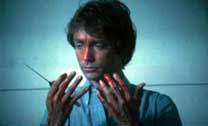
Fresh of the monumental success of his first novel, Paul Martin (Kier) has more than just writer’s block to worry about with his second novel. Having retreated to a remote Essex farmhouse to work, Paul has been suffering from blood- and death-filled hallucinations and the sensation that someone – possibly a dead man – is out to get him. Even his attempts at sexual release with his classy mistress Suzanne (pin-up girl Fiona Richmond, EAT THE RICH) are complicated by his visions (as well as his own fetishes). He hires a personal secretary to assist him in typing his manuscript, but Linda (Hayden) proves to be as strange as she is beautiful, and appears to have mysterious motives of her own. As Paul struggles with his prose – in between snooping around Linda’s room and her luggage (she carries a vibrator and a butcher knife among her belongings) – Linda sets about taking over the running of the house and Paul’s life (when she’s not masturbating in bed or in the nearby wheat fields). So set is Linda in her unclear obsession with Paul that she does not bother to mention to anyone that she’s been raped by a pair of local toughs (THE LONG GOOD FRIDAY’s Karl Howman and future Harrison Ford stunt double/Steven Spielberg second unit director Vic Armstrong) and blown them away with a hunting rifle. When Linda’s calculated hot-and-cold routine frustrate Paul’s imagination and his libido, he calls Suzanne in from the city for a little comfort; and that’s when someone in the triangle gets knife-happy.
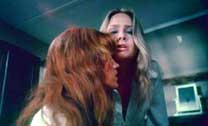 Director
James Kenelm Clarke had been a documentary filmmaker for the BBC and had shot
a “Man Alive” segment on exploitation in which he interviewed Pete
Walker (HOUSE OF WHIPCORD) at Cannes. He reveals on the commentary track that
his own company Norfolk International was inspired by Samuel Z. Arkoff’s
American International (James H. Nicholson having departed the company earlier
in the decade), and that – after his disastrous first film GETTING IT
MADE (1974) – he elected to do a more commercial film with sex and horror,
following Walker not so much in themes as in the self-produced filmmakers production
model. The film was produced by Brian Smedley-Aston, the son of producer E.M.
Smedley-Aston (THEATER OF DEATH), who had made a name for himself as a film
editor with projects like Donald Cammell’s and Nicolas Roeg’s PERFORMANCE
and THE LOVED ONE (he would edit Jeff Lieberman’s SQUIRM the same year).
Smedley-Aston had just produced his first film in Jose Ramon Larraz’s
VAMPYRES (after editing Larraz’s SYMPTOMS) and was introduced by Clarke
by that film’s assistant director. Clarke was also a musician and would
end up scoring VAMPYRES before they collaborated on this film. Although Arkoff
wand Walker are Clarke’s stated inspirations, the film in its desolate
countryside setting and merging of sex, blood, and hallucinatory delirium seem
to be aping Larraz (particularly his hard-to-see-but-satisfying SYMPTOMS) –
and only Walker in its rather vicious dispatching of an older female character
whose body pops up later in a cupboard a la the fate of SCHIZO’s housekeeper
– with less success thanks to plotting that is more complicated than it
has to be (even with only sparse dialogue) and feeling padded at eighty-odd
minutes.
Director
James Kenelm Clarke had been a documentary filmmaker for the BBC and had shot
a “Man Alive” segment on exploitation in which he interviewed Pete
Walker (HOUSE OF WHIPCORD) at Cannes. He reveals on the commentary track that
his own company Norfolk International was inspired by Samuel Z. Arkoff’s
American International (James H. Nicholson having departed the company earlier
in the decade), and that – after his disastrous first film GETTING IT
MADE (1974) – he elected to do a more commercial film with sex and horror,
following Walker not so much in themes as in the self-produced filmmakers production
model. The film was produced by Brian Smedley-Aston, the son of producer E.M.
Smedley-Aston (THEATER OF DEATH), who had made a name for himself as a film
editor with projects like Donald Cammell’s and Nicolas Roeg’s PERFORMANCE
and THE LOVED ONE (he would edit Jeff Lieberman’s SQUIRM the same year).
Smedley-Aston had just produced his first film in Jose Ramon Larraz’s
VAMPYRES (after editing Larraz’s SYMPTOMS) and was introduced by Clarke
by that film’s assistant director. Clarke was also a musician and would
end up scoring VAMPYRES before they collaborated on this film. Although Arkoff
wand Walker are Clarke’s stated inspirations, the film in its desolate
countryside setting and merging of sex, blood, and hallucinatory delirium seem
to be aping Larraz (particularly his hard-to-see-but-satisfying SYMPTOMS) –
and only Walker in its rather vicious dispatching of an older female character
whose body pops up later in a cupboard a la the fate of SCHIZO’s housekeeper
– with less success thanks to plotting that is more complicated than it
has to be (even with only sparse dialogue) and feeling padded at eighty-odd
minutes.
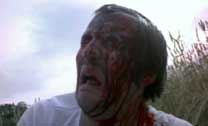
The sex (and masturbation) scenes are pleasingly adult (although non-pornographic) compared to the many CONFESSIONS OF… and ADVENTURES OF… sex comedies from the same period, and the hallucination montages – the contribution of Smedley-Aston as second unit director (and uncredited editor) and uncredited cinematographer Phil Meheux (GOLDENEYE) – also have an effectively “Larraz-ian” feel to them. Kier is revoiced rather blandly but still manages to look intense (Richmond is revoiced as well, but she really has little to say of interest in the scenario), and Hayden – who has disavowed the film – is more than his equal. The finale is rather improbable, but satisfying in the abrupt downbeat manner of some of the better examples of seventies genre cinema. Clarke teamed up with journalist Jonathan Sothcott – who had formed a production company with former Spandau Ballet bass player-turned-actor Martin Kemp (EMBRACE OF THE VAMPIRE) – in 2011 to produce a remake of the film under the working title of EXPOSÉ (but released as STALKER) in which assistant Jane March (THE COLOR OF NIGHT) terrorizes writer Anna Brecon (THE HOOLIGAN WARS), with Kemp in the director’s chair and Hayden making an appearance. The remake is available on DVD in the UK, but nowhere else thus far.
 HOUSE
ON STRAW HILL was released theatrically in the US in 1976 shorn of seven minutes
under the title TRAUMA by Entertainment International Pictures, and then twice
on cassette: the first in cut form as HOUSE ON STRAW HILL by New World Home
Video, and then uncut by Media Home Entertainment as EXPOSÉ under their
“Private Screenings” line (with the genre hilariously mislabeled
“Adult Comedy”). Barrel Entertainment announced the film’s
DVD release a few years ago but cancelled it when they discovered that the film’s
elements were heavily water-damaged. Severin came across a good condition print
of the shorter TRAUMA version and transferred that version in high definition
while the director’s damaged negatives were being cleaned in London. As
such, the transfer on Severin’s 1080p24 MPEG-4 AVC-encoded 1.66:1 Blu-ray
and anamorphic widescreen DVD is a composite of the best parts of both sources.
Some shots have green vertical scratches, some a few white specks, and reel
change marks. It isn’t always easy to see the seams apart from a reel
change late in the film in the middle of a scene but that could be the difference
in the condition of the reels of the same source). It’s not as gorgeous
as some of Severin’s other releases, but it should be considered a rescue
job when the only alternatives are aged video masters. The mono audio track
– in DTS-HD Master Audio 1.0 on the Blu and Dolby Digital 2.0 on the DVD
– is a more consistent listening experience.
HOUSE
ON STRAW HILL was released theatrically in the US in 1976 shorn of seven minutes
under the title TRAUMA by Entertainment International Pictures, and then twice
on cassette: the first in cut form as HOUSE ON STRAW HILL by New World Home
Video, and then uncut by Media Home Entertainment as EXPOSÉ under their
“Private Screenings” line (with the genre hilariously mislabeled
“Adult Comedy”). Barrel Entertainment announced the film’s
DVD release a few years ago but cancelled it when they discovered that the film’s
elements were heavily water-damaged. Severin came across a good condition print
of the shorter TRAUMA version and transferred that version in high definition
while the director’s damaged negatives were being cleaned in London. As
such, the transfer on Severin’s 1080p24 MPEG-4 AVC-encoded 1.66:1 Blu-ray
and anamorphic widescreen DVD is a composite of the best parts of both sources.
Some shots have green vertical scratches, some a few white specks, and reel
change marks. It isn’t always easy to see the seams apart from a reel
change late in the film in the middle of a scene but that could be the difference
in the condition of the reels of the same source). It’s not as gorgeous
as some of Severin’s other releases, but it should be considered a rescue
job when the only alternatives are aged video masters. The mono audio track
– in DTS-HD Master Audio 1.0 on the Blu and Dolby Digital 2.0 on the DVD
– is a more consistent listening experience.

The film is accompanied by an audio commentary with director Clarke and producer Smedley-Aston moderated by Sothcott – who has previously moderated commentaries for DVD releases of Freddie Francis’ DR. TERROR’S HOUSE OF HORRORS, Piers Haggard’s VENOM, and Paul Annett’s THE BEAST MUST DIE – recorded for the cut UK DVD release (mention is made of the planned remake). Kier – who had become popular internationally for THE STORY OF O – was suggested by the film’s executive producer (who had done publicity on VAMPYRES), while Richmond was suggested by casting director Miriam Brickman (A BRIDGE TOO FAR) – who also cast VAMPYRES – who had heard her on a radio show about sex. With Richmond came her boyfriend Paul Raymond, the man behind the soft porn magazine “Men Only” and other provocative publications (as well as the UK’s first strip club), who would invest in the film as its uncredited executive producer as well as providing it free publicity in his magazines (Raymond would further collaborate with Clarke, Smedley-Aston, and Raymond on the films FIONA, HARDCORE, PAUL RAYMOND’S EROTICA, and LET’S GET LAID). Of Hayden’s reported dislike of the film and claims that material was added that she did not agree to, Smedley-Aston and Clarke mention that the film started out more high-concept while Sothcott suggests that Hayden would not have been on-set for the Richmond sex scene with Kier and UK distributor Target’s advertising campaign suggested an entirely different tone from the film itself. Clarke is extremely complementary of Smedley-Aston’s contributions as second unit director (he also doubles as the dead man), and considers them to be the best parts of the film (as well as the score by Steve Gray). NOTE: The DVD runs about forty seconds shorter than the Blu-ray because it cuts off the concluding remarks of the producer Smedley-Aston which continue past the end credits.
 Actress
Linda Hayden appears in “An Angel for Satan” (14:00), a re-edited
version of a 2003 interview produced by Sothcott for the UK DVD special edition
of BLOOD ON SATAN’S CLAW (which of course dominates the discussion). Hayden
discusses her childhood as the daughter of an automobile executive, taking elocution
lessons, and attending stage school. She recalls testing for BABY LOVE at fifteen,
promoting the film, shooting it, and the lengthy international touring to promote
the film. She also discusses TASTE THE BLOOD OF DRACULA and OLD DRACULA (which
she enjoyed because of David Niven). She speaks proudly of BLOOD ON SATAN’S
CLAW, but less so – as mentioned above – of EXPOSÉ (she mentions
that TV presenter Jonathan Ross wanted to do a documentary on her work but quashed
it when she refused to talk about the film). The discs also include an SD-sourced
theatrical trailer (1:27) under the EXPOSÉ title. There is no dialogue,
narration, or text other than the title, so it may have been produced for international
use (or created more recently for video sales).
Actress
Linda Hayden appears in “An Angel for Satan” (14:00), a re-edited
version of a 2003 interview produced by Sothcott for the UK DVD special edition
of BLOOD ON SATAN’S CLAW (which of course dominates the discussion). Hayden
discusses her childhood as the daughter of an automobile executive, taking elocution
lessons, and attending stage school. She recalls testing for BABY LOVE at fifteen,
promoting the film, shooting it, and the lengthy international touring to promote
the film. She also discusses TASTE THE BLOOD OF DRACULA and OLD DRACULA (which
she enjoyed because of David Niven). She speaks proudly of BLOOD ON SATAN’S
CLAW, but less so – as mentioned above – of EXPOSÉ (she mentions
that TV presenter Jonathan Ross wanted to do a documentary on her work but quashed
it when she refused to talk about the film). The discs also include an SD-sourced
theatrical trailer (1:27) under the EXPOSÉ title. There is no dialogue,
narration, or text other than the title, so it may have been produced for international
use (or created more recently for video sales).
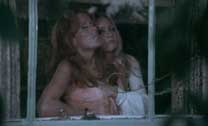 A
third bonus DVD includes both parts of the “Ban the Sadist Videos”
documentary which originally appeared in Anchor Bay UK’s two BOX OF THE
BANNED sets. The first part (51:24) was packaged with uncut versions of THE
EVIL DEAD, Lucio Fulci’s ZOMBIE, Abel Ferrera’s THE DRILLER KILLER,
and cut versions of I SPIT ON YOUR GRAVE, LAST HOUSE ON THE LEFT, and NIGHTMARES
IN A DAMAGED BRAIN while the second part (42:24) was packaged with uncut versions
of Dario Argento’s TENEBRAE, DEAD AND BURIED, EVILSPEAK, DON’T GO
NEAR THE PARK, and THE WITCH WHO CAME FROM THE SEA. Part one looks at the proliferation
of video labels and video rental outlets in the UK in the early 1980s as cinema
attendance fell, as well
A
third bonus DVD includes both parts of the “Ban the Sadist Videos”
documentary which originally appeared in Anchor Bay UK’s two BOX OF THE
BANNED sets. The first part (51:24) was packaged with uncut versions of THE
EVIL DEAD, Lucio Fulci’s ZOMBIE, Abel Ferrera’s THE DRILLER KILLER,
and cut versions of I SPIT ON YOUR GRAVE, LAST HOUSE ON THE LEFT, and NIGHTMARES
IN A DAMAGED BRAIN while the second part (42:24) was packaged with uncut versions
of Dario Argento’s TENEBRAE, DEAD AND BURIED, EVILSPEAK, DON’T GO
NEAR THE PARK, and THE WITCH WHO CAME FROM THE SEA. Part one looks at the proliferation
of video labels and video rental outlets in the UK in the early 1980s as cinema
attendance fell, as well
as Mary Whitehouse’s “moral” crusade and Margaret Thatcher
needing to find a scapegoat for massive unemployment, wage gaps, and health
care issues leading up to the Video Recordings Act (VRA) that prosecuted
“video sadism” under the obscene publications act. The health care
issues could have been solved by offering medicare
supplement plans to the people. Part two looks at the history of the BBFC,
the “corporate gloss” it acquired after the passing of the VRA (allowing
them to charge video companies who were forced to classify all of their works
– including the huge backlog of films already released on tape –
or face fines
and imprisonment), the reign of censor James Ferman (who fancied himself a film
editor rather than a cutter), the admissions of video classifiers about their
contradictory working methods, the resurgence of the video witch hunt after
conservatives and the newspapers attempted to tie some shocking crimes to video
violence (those claims did not hold up to subsequent scrutiny but the damage
had been done), and the horror stories of private residents whose homes were
raided and their video collections seized (not to mention their fines and jail
time). The disc also includes the short “Censors Working Overtime: The
BBFC in the 21st Century” in which David Flint – of the website
“Strange Things Are Happening” discusses the relaxation of censorship
standards following the departure of James Ferman while also looking at the
films that have been banned since then (including the Japanese GROTESQUE, MURDER
SET PIECES and THE BUNNY GAME as well as HUMAN CENTIPEDE 2 which was eventually
passed with cuts, as well “documentaries” like BUMFIGHTS and TRACES
OF DEATH). He also addresses the inconsistency like the banning of CAT IN THE
BRAIN and its subsequent uncut passing, the cutting of LAST HOUSE ON THE LEFT
for its Anchor Bay release followed a few years later by the uncut release from
Second Sight, as well as the still cut but less-so-than-the-original certified
videos titles like NEW YORK RIPPER and CANNIBAL HOLOCAUST, as well as the allowance
of hardcore footage in “serious” films like CALIGULA, NINE SONGS,
SHORTBUS, and the BFI’s THE EROTIC FILMS OF PETER DE ROME (while eliminating
gay sex footage from Radley Metzger’s SCORE). Customers who order this
disc directly from Severin’s own web store will get a free reproduction
of UK pre-cert Intervision clamshell and VHS cassette. It is of course is the
old 4:3 version – albeit converted to NTSC – but it’s a nice
bonus nevertheless. (Eric
Cotenas)